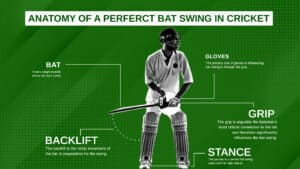Cricket, a global sport celebrated in many corners of the world, is an intricate game that relies heavily on technique, precision, and timing. One of the critical skills in cricket is the art of batting, specifically the perfect bat swing.
In this article, we at Cricket Expert will dissect the anatomy of a perfect bat swing in cricket, compare it with some unique batting styles of legendary cricketers, and explore how those differing styles have been successful in their ways.
Whether you're a seasoned cricketer, an aspiring player, or just a passionate fan, this comprehensive guide should illuminate some fascinating aspects of this glorious sport.
Components of a Perfect Bat Swing
Let's have a look at the most important components of bat swing. From grip to stance, from backlift to proper connection of the ball, we will explain everything in detail. Exploring crucial aspects such as grip, stance, backlift, and the art of connecting with the ball, we leave no stone unturned.
Grip
The grip is arguably the batsman's most critical connection to the bat and therefore significantly influences the bat swing. Understanding the proper grip and stance allows for a solid foundation, while mastering the backlift ensures optimal power and control.

1. Positioning: Hold the bat handle with both hands close together towards the top. The top hand (left hand for a right-handed batsman and vice versa) should be positioned so that the knuckles are facing the bowler, and the thumb and forefinger form a ‘V' shape along the back of the handle.
2. Pressure: The grip should be firm but relaxed. Holding the bat too tightly can restrict movement and impact timing, while a too-loose grip may lead to a lack of control.
3. Flexibility: The grip should allow for flexibility in the wrists. This flexibility can help the batsman control the bat swing, generate more power, and manipulate the bat angle to guide the ball's direction.
Here are primarily three types of grips used by players: the orthodox grip, the neutral grip, and the switch grip. These grips refer to how a batsman holds the cricket bat
Orthodox Grip
The orthodox grip is the most common grip used by batsmen. In this grip, the top hand (left hand for a right-handed batsman and vice versa) is placed above the bottom hand on the handle of the bat. The fingers wrap around the handle with the knuckles aligned. This grip allows for a balanced and controlled stroke play.
Neutral Grip
The neutral grip is a variation of the orthodox grip. In this grip, the top hand is moved slightly lower on the handle, closer to the bottom hand. This grip is often used by batsmen who prefer a more bottom-handed technique, generating power and playing shots predominantly off the back foot.
Switch Grip
The switch grip is a unique grip where a batsman changes their hand position to adopt a grip opposite to their natural batting style. This grip involves the top hand being positioned below the bottom hand on the handle, essentially reversing the orthodox grip. Switch grips are predominantly used by batsmen to gain an advantage against spin bowlers or to surprise the fielding team with unorthodox shot selection.
Stance
The journey to a perfect bat swing starts with the right stance. The batter, or ‘batsman,' should stand side-on to the bowler with feet shoulder-width apart parallel to the crease. This positioning allows the batsman to maintain balance and facilitates movement in any direction.
The bat's handle should be comfortably gripped, with the top hand's knuckles pointing towards the bowler and the bottom hand's towards the leg slip. The batsman's head should be still, eyes level, and focus trained on the bowler's hand. Here are some famous stances of cricketers known for their distinct and recognizable batting stances:

Sir Don Bradman: The legendary Australian cricketer, Sir Don Bradman, had a unique and iconic stance. He stood upright with his feet close together and his bat held high above his head. This stance allowed him to have quick footwork and excellent balance.
Shivnarine Chanderpaul: The former West Indian batsman, Shivnarine Chanderpaul, had an unorthodox stance that became his trademark. He stood with an open and side-on stance, with his back foot turned almost 90 degrees to the pitch. Chanderpaul's stance helped him to play deliveries from different angles with great efficiency.
Steve Smith: The Australian cricketer, Steve Smith, has a distinctive stance that has gained attention in recent years. He stands with a slight crouch, with his head leaning forward and his back shoulder dropped. This stance allows him to track the ball closely and make precise movements.
Backlift
The backlift is the initial movement of the bat in preparation for the swing. The bat should be lifted such that the face points towards the gully or point rather than the sky. This positioning allows the batsman to get on top of the ball, contributing to better control and power. It also places the batsman in a position to react to any line or length swiftly.
There have been several famous cricketers known for their amazing backlift. Here are some of the top cricketers who mesmerized everyone during their playing days:
Sir Vivian Richards: The legendary West Indian batsman, Sir Vivian Richards, had a distinctive high backlift. His backlift was very pronounced, almost pointing towards the slips, which allowed him to generate immense power and play aggressive shots.
Sachin Tendulkar: Considered one of the greatest batsmen of all time, Sachin Tendulkar had a unique and high backlift. His backlift started from a high position and came down sharply as he prepared to play his shots. This technique allowed him to generate quick bat speed and play a wide range of strokes with precision.
Ricky Ponting: The former Australian captain, Ricky Ponting, had a slightly more upright and classical backlift. Although not as high as some others on this list, Ponting's backlift was still notable for its precision and effectiveness. It allowed him to be in a strong position to play both attacking and defensive strokes.

Downswing
As the ball approaches, the batsman transitions into the downswing or the “strike” phase. The top hand controls the bat's direction, while the bottom hand provides power. The batsman's front shoulder should point towards the incoming ball, and the head should remain still and focused on the ball.
Contact
At the point of contact, the bat should be ‘presented' full-face to the ball for a defensive shot, and at an angle for an attacking shot. The timing of this is crucial – too early, and the batsman might scoop the ball in the air; too late, and the batsman could miss entirely. The body weight should transfer into the shot, and the front foot should step toward the ball.
Follow-through
After contact, the follow-through becomes essential for maintaining balance and ensuring the ball is directed as intended. The bat should continue on its path, guided by the hands and body motion, to complete the swing.
Below is an in-depth look at how the bat swing differs when playing shots on the front foot as compared to the back foot:
Front Foot Shots
We will explain you in detail about how the perfect front foot shots are played by the batters and what are the most important things you need to keep in mind while playing the perfect front foot shots.
Stance and Footwork
- When playing a front foot shot, the batsman moves his front foot (the foot closer to the bowler) towards the pitch of the ball.
- The weight is transferred onto the front foot, and the head moves forward and over the front knee.
Backlift and Bat Swing
- The backlift is generally higher and the bat is lifted in the direction of the first or second slip.
- The swing starts from a high backlift and follows through in the direction of the shot.
- The bat face may open up or stay more perpendicular to the ground depending on the desired shot (e.g. straight drive, cover drive).
- The bat swing has a fuller arc and is generally smoother as the batsman tries to hit the ball along the ground.
Common Front Foot Shots
- Drive
- Cover Drive
- On-Drive
- Forward Defense
Back Foot Shots
We will explain you in detail about how the perfect back foot shots are played by the batters and what are the most important things you need to keep in mind while playing the perfect backfoot shots.
Stance and Footwork
- For back foot shots, the batsman moves his back foot (the foot further from the bowler) toward the stumps or even deeper into the crease.
- The weight is transferred to the back foot, and the body stays more upright compared to the front foot shots.
Backlift and Bat Swing
- The backlift is shorter compared to front foot shots, and the bat is lifted more in the direction of the gully or point.
- The swing is quicker and more horizontal as the batsman often plays cut or pull shots.
- The bat face is more likely to be angled or rolled over, especially in the case of a hook or pull shot, to control the height and direction of the ball.
- The bat swing has a more abrupt and compact nature, as the batsman has less time to react to short-pitched deliveries.
Common Back Foot Shots
- Cut
- Pull
- Hook
- Back-foot Defence
The cricketing equipment, particularly the bat and gloves, play a significant role in a batsman's bat swing. Here is a detailed explanation of how this equipment is related to a batsman’s bat swing:
The cricketing equipment, particularly the bat and gloves, play a significant role in a batsman's bat swing. Here is a detailed explanation of how this equipment is related to a batsman’s bat swing:
Cricket Bat:
- a) Weight: A bat's weight directly affects the bat's swing. Lighter bats tend to allow for quicker bat speed, which is beneficial for playing fast bowlers or reacting to short-pitched deliveries. However, heavier bats can provide more power and stability, particularly in driving shots or playing against spinners.
- b) Balance: The balance of the bat is crucial. Bats with a lower center of gravity might aid in playing front-foot shots, as they can feel lighter in the hands and allow for a smoother swing. Bats with a higher center of gravity might be better for back-foot shots, as they can help generate more power in horizontal bat shots like cuts and pulls.
- c) Sweet Spot: The position of the sweet spot (the area of the bat that imparts the most power to the ball) affects the bat's swing. A bat with a higher sweet spot might be preferred for backfoot play, while a bat with a lower sweet spot could be more effective for front-foot shots.
- d) Handle: The shape and size of the bat handle can also affect the swing. Oval handles can offer more control, which might be beneficial for players who rely on timing and finesse. Round handles can allow for more aggressive bottom-hand dominant play.Cricket Gloves
- a) Grip: The primary role of gloves in influencing bat swing is through the grip. Good quality gloves provide a comfortable and secure grip on the bat handle. A secure grip is essential for control over the bat swing, ensuring that the bat does not turn in the hands upon impact.
- b) Flexibility: Gloves need to be flexible to allow for the range of wrist movements needed in various shots. For instance, wristy flicks or late cuts require considerable wrist mobility, which would be hindered by stiff gloves.
- c) Protection and Comfort: Well-padded gloves protect the hands from impact shocks, especially against fast bowlers. If a batsman is comfortable and not worried about pain from the impact, they can focus more on the fluidity and technique of their bat swing.
- d) Sweat Absorption: Good gloves will absorb sweat and prevent the hands from becoming slippery. This is crucial for maintaining a consistent grip and ensuring that the bat does not slip or change position during the swing.
In conclusion, a batsman should choose a bat and gloves that are well-suited to their style of play and preferences. The right equipment can greatly enhance the effectiveness and consistency of a batsman’s bat swing, while the wrong equipment can hinder performance.
Technique Vs. Power in a Bat Swing
When dissected, both elements have their distinct places in the game, yet their intersection is where the real magic happens. Let's dive deeper into both.

Technique: The Catalyst of Precision and Consistency
In cricket, batting technique refers to the fundamental mechanics of a bat swing. It involves the right stance, correct grip, suitable backlift, precise downswing, the optimal point of contact, and balanced follow-through. A sound technique is the blueprint of a consistent and reliable bat swing.
Batsmen with excellent technique are often adept at playing a wide array of shots, managing diverse pitch conditions, and dealing with various bowling styles. They can consistently find gaps, maintain a good strike rate, and rarely give away their wicket due to technical flaws. In essence, the technique is the catalyst of precision and consistency in a bat swing.
Power: The Force Behind Impact
Power, on the other hand, refers to the force exerted on the ball at the point of contact. It's the ingredient that allows the ball to race away to the boundary or soar over it for a six. Power in a bat swing is derived from a combination of physical strength, timing, and bat speed.
Powerful hitters can change the complexion of the game rapidly with their big-hitting prowess. They're particularly impactful in shorter formats of the game, such as T20 cricket, where the run rate is crucial. However, power without control can lead to recklessness, resulting in a loss of wickets.
Technique and Power: The Perfect Blend
The perfect bat swing is a harmonious blend of technique and power. While technique ensures consistency and adaptability, power provides the ability to dominate and dictate the game's pace.
Some of the game's greatest batsmen, such as Sachin Tendulkar, Sir Vivian Richards, and AB de Villiers, embodied this balance. They could defend technically perfect deliveries when required, attack with immense power when the opportunity arose, and adapt their game based on the match situation.
However, if one had to prioritize, a strong foundation in technique is generally recommended, especially for budding cricketers. Power can often be developed with time through physical conditioning, practice, and experience. But, without a solid technique, a player might struggle with consistency, adaptability, and longevity in the game.
In conclusion, the debate between technique and power in a bat swing isn't about choosing one over the other. Instead, it's about understanding how both elements interact and complement each other in the grand spectacle of cricket.
To explore the nuances of bat swing in cricket, let's compare two Indian legends: Sachin Tendulkar and Virender Sehwag. Their styles were starkly different, yet both were immensely successful in their careers.
Sachin Tendulkar: The Master Technician
Regarded as one of the greatest batsmen in the history of cricket, Sachin Tendulkar was the epitome of technical perfection. His bat swing was a classic example of the textbook style and is often used as a reference point in cricket coaching.
- Stance and Grip: Tendulkar's stance was balanced and side-on, providing him with a solid base. His grip was orthodox, with the top hand's knuckles facing the bowler, giving him excellent control over the bat.
- Backlift and Downswing: His backlift was high and towards the gully, facilitating a wide range of shots. His downswing was controlled primarily by his top hand, with the bottom hand providing power.
- Contact and Follow-through: The point of contact was usually under his eyes, allowing precise timing and direction. His follow-through was complete and balanced, contributing to his outstanding placement.
Tendulkar's bat swing was known for its grace and precision. His technique allowed him to tackle all types of bowling attacks and adapt to varying conditions, making him a consistent scorer in all formats of the game.

Virender Sehwag: The Destructive Power-hitter
Virender Sehwag, on the other hand, was known for his explosive batting style. He believed in the simple philosophy of “see the ball, hit the ball,” which led to a distinctive bat swing.
- Stance and Grip: Sehwag's stance was wide and open, allowing him to free his arms. His grip was strong and flexible, enabling him to swing the bat powerfully.
- Backlift and Downswing: Sehwag's backlift was not as high as Tendulkar's, but it was swift, enabling him to generate considerable bat speed in his downswing. His downswing was more bottom-hand dominant, generating power and allowing him to hit through the line.
- Contact and Follow-through: Sehwag often made contact with the ball in front of his body, indicative of his aggressive intent. His follow-through was strong and assertive, often sending the ball soaring over the boundary.
Sehwag's bat swing was synonymous with power and fearlessness. His aggressive approach often put the bowlers under pressure, giving his team a rapid start, particularly in Test cricket, where he was a game-changer.
Conclusion: Different Styles, Similar Success
Tendulkar and Sehwag provide an interesting study in contrast. Tendulkar's technically sound bat swing and Sehwag's power-packed style both led to immense success, underlining the fact that there isn't one ‘perfect' bat swing in cricket. The perfect swing suits the batsman's natural game, strengths, and temperament, allowing them to score runs consistently under various conditions and pressures.
Understanding and Embracing Diversity
These examples illustrate that the ‘perfect' bat swing can vary from player to player, with each adapting to their strengths, weaknesses, and idiosyncrasies. Though cricket coaching manuals might prescribe certain ‘correct' techniques, the fluid nature of the sport allows for variations and adaptations. The perfect bat swing, thus, is not a rigid concept but a harmonious synchronization of stance, backlift, downswing, contact, and follow-through that feels ‘right' for the individual player.
What matters at the end of the day is the effectiveness of the swing – can it consistently meet the ball and direct it as intended? Can it withstand the variations in pace, swing, and spin that a bowler will undoubtedly unleash? And can it adapt to the varying conditions of pitch, weather, and match situation? If the answer to these questions is yes, then regardless of its conformity to the ‘textbook' style, the bat swing can be deemed perfect for that player.
In conclusion, the perfect bat swing in cricket is an amalgamation of technique, timing, and intuition. The beauty of cricket lies in the diversity of its participants and the uniqueness of their styles. Whether conventional or unconventional, each batsman crafts a distinctive symphony of movements that, when executed well, can turn the cricket ground into a stage of sublime performance.









